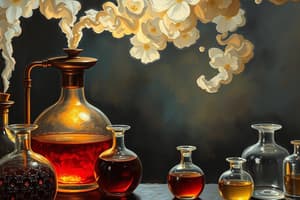Podcast
Questions and Answers
Why must oil be free from organic acids before vacuum distillation?
Why must oil be free from organic acids before vacuum distillation?
- To improve the color of the oil
- To enhance the flavor of the oil
- To increase the boiling point of the oil
- To prevent the hydrolysis of the ester (correct)
What process is used to identify esters?
What process is used to identify esters?
- Saponification (correct)
- Distillation
- Filtration
- Preciptation
What will likely happen if organic acids are present during the distillation of oil?
What will likely happen if organic acids are present during the distillation of oil?
- Color change in the oil will be accelerated
- The boiling point will decrease
- The oil will become solid
- Ester hydrolysis can occur (correct)
Which of the following is a consequence of ester hydrolysis during distillation?
Which of the following is a consequence of ester hydrolysis during distillation?
What is the primary goal of using vacuum during fraction distillation of oil?
What is the primary goal of using vacuum during fraction distillation of oil?
What is one primary use of Gaultherin?
What is one primary use of Gaultherin?
Which property is associated with Methyl salicylate?
Which property is associated with Methyl salicylate?
What function does Gaultherin serve in terms of inflammation?
What function does Gaultherin serve in terms of inflammation?
Which of the following is NOT a property of Methyl salicylate?
Which of the following is NOT a property of Methyl salicylate?
What role does Methyl salicylate play in dental care?
What role does Methyl salicylate play in dental care?
What complex is formed during the isolation of the substance described?
What complex is formed during the isolation of the substance described?
What happens to the substance when exposed to air?
What happens to the substance when exposed to air?
Which property indicates that the substance has potential use against microorganisms?
Which property indicates that the substance has potential use against microorganisms?
What physical state is described for the substance?
What physical state is described for the substance?
What is a characteristic property of the substance related to its stability?
What is a characteristic property of the substance related to its stability?
What type of infections do powerful broad-spectrum agents combat?
What type of infections do powerful broad-spectrum agents combat?
Which of the following is NOT a characteristic of broad-spectrum agents?
Which of the following is NOT a characteristic of broad-spectrum agents?
How is the immune system described in relation to powerful broad-spectrum agents?
How is the immune system described in relation to powerful broad-spectrum agents?
Which of the following does NOT relate to the use of powerful broad-spectrum agents?
Which of the following does NOT relate to the use of powerful broad-spectrum agents?
What is an additional benefit of using broad-spectrum agents mentioned in the content?
What is an additional benefit of using broad-spectrum agents mentioned in the content?
What is the appearance of the isolated product from Cassia and cinnamon oils?
What is the appearance of the isolated product from Cassia and cinnamon oils?
What odor is characteristic of the isolated product from Cassia and cinnamon oils?
What odor is characteristic of the isolated product from Cassia and cinnamon oils?
What transformation occurs to the product when it is exposed to air?
What transformation occurs to the product when it is exposed to air?
How is the product from Cassia and cinnamon oils regenerated?
How is the product from Cassia and cinnamon oils regenerated?
Which chemical complexes are used to isolate the product from Cassia and cinnamon oils?
Which chemical complexes are used to isolate the product from Cassia and cinnamon oils?
What is deposited on the filter paper disc during the combustion test?
What is deposited on the filter paper disc during the combustion test?
What is used to moisten the inner surface of the inverted beaker in the combustion test?
What is used to moisten the inner surface of the inverted beaker in the combustion test?
In the combustion test, where is the filter paper disc placed?
In the combustion test, where is the filter paper disc placed?
What is the primary purpose of the combustion test?
What is the primary purpose of the combustion test?
What happens to the beaker during the combustion test?
What happens to the beaker during the combustion test?
Flashcards
Fraction distillation under vacuum
Fraction distillation under vacuum
A distillation method used for separating components of an oil mixture under reduced pressure.
Organic acid
Organic acid
Hydrocarbon compounds with carboxyl group.
Hydrolysis of the ester
Hydrolysis of the ester
Decomposition of an ester by water
Preventing hydrolysis of ester
Preventing hydrolysis of ester
Signup and view all the flashcards
Ester
Ester
Signup and view all the flashcards
Saponification
Saponification
Signup and view all the flashcards
Isolation of Na bisulfite complex
Isolation of Na bisulfite complex
Signup and view all the flashcards
Properties of Isolation product
Properties of Isolation product
Signup and view all the flashcards
Vaginal Candidiasis Treatment
Vaginal Candidiasis Treatment
Signup and view all the flashcards
Gaultherin's use
Gaultherin's use
Signup and view all the flashcards
Methyl salicylate function
Methyl salicylate function
Signup and view all the flashcards
Aspirin substitute
Aspirin substitute
Signup and view all the flashcards
Anti-inflammatory action
Anti-inflammatory action
Signup and view all the flashcards
Methyl salicylate types
Methyl salicylate types
Signup and view all the flashcards
Anticariogenic agent
Anticariogenic agent
Signup and view all the flashcards
Cinnamon oil isolation
Cinnamon oil isolation
Signup and view all the flashcards
Cinnamon oil appearance
Cinnamon oil appearance
Signup and view all the flashcards
Cinnamon oil oxidation
Cinnamon oil oxidation
Signup and view all the flashcards
B-Combustion Test Procedure
B-Combustion Test Procedure
Signup and view all the flashcards
Study Notes
Esters
- Many volatile oils get their odor and flavor from esters, like acetate of terpineol, borneol, and geraniol.
- Aging improves the smell and value of perfumes through esterification.
- Some esters solidify at room temperature, allowing separation by cooling (e.g., benzyl benzoate).
- Esters can be isolated from essential oils through shaking with dilute sulfuric acid and recrystallization with alcohol.
- Fraction distillation under vacuum is needed to isolate esters, ensuring no acid is present to prevent hydrolysis.
- Esters are identified through saponification, determining the corresponding acid and alcohol.
Important Esters in Volatile Oils
- Aliphatic acid esters: Geranyl acetate and linalyl acetate.
- Aromatic acid esters: Benzyl benzoate and methyl salicylate.
- Nitrogen-containing esters: Methyl anthranilate.
Geranyl Acetate
- Structure: A colorless liquid with a pleasant fruity odor.
- Source: Oil of citronella, lemongrass, petit grain, lavender, and coriander.
- Isolation: Fractionation distillation under vacuum.
- Properties: Colorless liquid, pleasant fruity odor.
- Identification: Saponify the ester. Identify geraniol and acetic acid.
- Uses: Perfume, cosmetics, and food industry, natural antioxidant, to prevent cancer, antimicrobial.
Linalyl Acetate
- Structure: Colorless liquid with a pleasant fruity odor, specifically of bergamot.
- Source: Lavender and bergamot oils.
- Isolation: Fraction distillation under vacuum (hydrolysis in atmospheric pressure).
- Properties: Colorless liquid, pleasant fruity odor.
- Identification: Saponify the ester. Identify linalool and acetic acid.
- Uses: Perfume, antioxidant, effective antimicrobial, antispasmodic, fungicide.
Methyl Salicylate
- Structure: Colorless oil with a powerful odor and flavor.
- Source: Oil of wintergreen (Gaultheria procumbens).
- Isolation: Enzymatic hydrolysis followed by distillation.
- Properties: Colorless oil, powerful odor and flavor. FeCl3 solution creates a red-violet color.
- Identification: Saponify the ester. Identify methanol and salicylic acid.
- Uses: Natural substitute of Aspirin, local anti-inflammatory, antirheumatic and anticariogenic agent.
Methyl Anthranilate
- Source: Oil of neroli, jasmine, and ylang ylang.
- Isolation: Shaking the oil with dilute (H2SO4), ester is regenerated by NaOH.
- Properties: Crystalline mass with a powerful taste, special odor, resembles orange blossoms. Has blue violet fluorescence.
- Identification: Formation of derivatives (picrate needles).
- Uses: Antifungal activity.
Determination of Esters
- Procedure: Saponify the ester using standard alcoholic potassium hydroxide (KOH).
- The amount of alkali consumed is determined by back-titrating the excess with a standardized acid.
- Calculate the percentage of ester from this.
General Precautions
- Some esters take longer than an hour to saponify completely (e.g., salicylates and menthyl acetate).
- In dark-colored oils, dilute the saponified oil with alcohol to accurately measure the end point of titration.
Studying That Suits You
Use AI to generate personalized quizzes and flashcards to suit your learning preferences.




